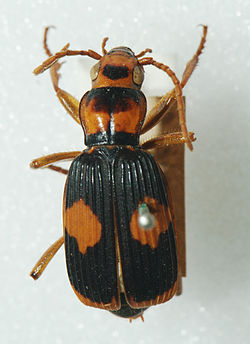Bombardier beetle
| The divine comedy Creationism |
| Running gags |
| Jokes aside |
| Blooper reel |
| Evolutionism debunkers |
Bombardier beetles are over 500 species of ground beetles (the tribes Brachinini, Paussini, Ozaenini, and Metriini within the family Carabidae) that are most notable for their defense mechanism: when threatened, these beetles eject a noxious chemical spray (consisting of hydrogen peroxide and hydroquinone) in a rapid, pulsating burst from special glands in the abdomen.
The science[edit]
The proven science behind the beetle's defenses is that it uses a mixture of two enzymes, hydroquinone and hydrogen peroxide (H2O2) that it mixes together (a catalase to decompose the hydrogen peroxide, and a peroxidase to oxidize the hydroquinones and thereby break them down into the simpler quinones), causing the mixture to heat to nearly 100°C. Inside the insect's defense system, there are two chambers: the larger inner chamber (called the "reservoir" or "collection bladder") empties into the smaller outer one (called the "vestibule" or "explosion chamber"), which in turn empties into the outside world through an opening near the anus. There are two sets of these organs, one on each side of the anus. The collection bladder collects hydrogen peroxide and hydroquinone. The explosion chamber collects a brown gooey mixture of the two enzymes and has a thick chitin wall with numerous little holes in it through which single-celled glands secrete and deposit the enzymes into the chamber. When the insect's defenses become stimulated, a muscle opens up and through this opening, the two chemicals are forced into the explosion chamber, where the enzymes cause them to explode out of the insect's derrière as oxygen, quinone, and water.
From an evolutionary standpoint, hydrogen peroxide is a normal metabolic byproduct found in insects and various quinones are used to harden (or "sclerotinize") insect cuticles. As a byproduct, hydroquinone tastes bad to predators and, for example, is the chemical that makes stink bugs (family Pentatomidae![]() ) stink. So, if an insect's cuticle became indented, forming little sacs to store some of this hydroquinone, it would have an evolutionary advantage over its fellows. Furthermore, it is a well-known trait of the carabid family (of which the bombardier beetles are members) to have bladders for the secretion of various poisons. Therefore, from an evolutionary standpoint, it was only a minor evolutionary step for the bombardier beetle to hold both of these chemicals, and all they would need to do is evolve a ready supply of the mixture enzymes.[1]
) stink. So, if an insect's cuticle became indented, forming little sacs to store some of this hydroquinone, it would have an evolutionary advantage over its fellows. Furthermore, it is a well-known trait of the carabid family (of which the bombardier beetles are members) to have bladders for the secretion of various poisons. Therefore, from an evolutionary standpoint, it was only a minor evolutionary step for the bombardier beetle to hold both of these chemicals, and all they would need to do is evolve a ready supply of the mixture enzymes.[1]
Creationist nonsense[edit]
“”I thought that the style of brainwashing seen in this revisionist book went out with the 1950s Cold War era. However, the Institute for Creation Research demonstrates that brainwashing is alive and well as it continues to wage its own cold war against reason in order to replace it with superstition. In this highly disjointed little book, the target is young children, which makes the authors’ sin of deliberate ignorance even more reprehensible. Educating children about the wonders of nature is a delightful endeavor, but here it is a vehicle for blatantly meshing pseudo-natural history with creationist dogma that has, at no extra charge, a good dose of patriarchal sexism thrown in…
|
| —An honest review of Bomby the Bombardier Beetle[2] |
While there is ample research into the beetle's evolutionary background and ample proof to back that evolutionary background up, creationists have held up the beetle as a prime example of irreducible complexity, citing the false belief that having both chemicals inside its body at the same time would cause the beetle to burst had it not been by the grace of God that He created it with two sacs in which to hold the chemicals.[3] The Institute for Creation Research has even written a children's book called Bomby the Bombardier Beetle[2] which attempts to teach this nonsense to the gullible.
In creationist cryptozoological lore, small acid-squirting bombardier beetles can also serve as analogs ("evidence") for large fire-breathing dragons[4] which the faithful detect in the Old Testament,[note 1] in the New Testament,[5] and in the Apocrypha[6] of the Bible.
External links[edit]
Notes[edit]
References[edit]
- ↑ The Bombardier Beetle Myth Exposed
- ↑ 2.0 2.1 Epic Creationist FAIL: Bombardier Beetle Book. skepchick, 23 June 2012.
- ↑ An example from Answers in Genesis
- ↑ Could a fire-breathing dragon be a possibility? WorldNetDaily.com
- ↑ For example: Revelation 12:3-17
- ↑ See the Wikipedia article on Bel and the Dragon.
